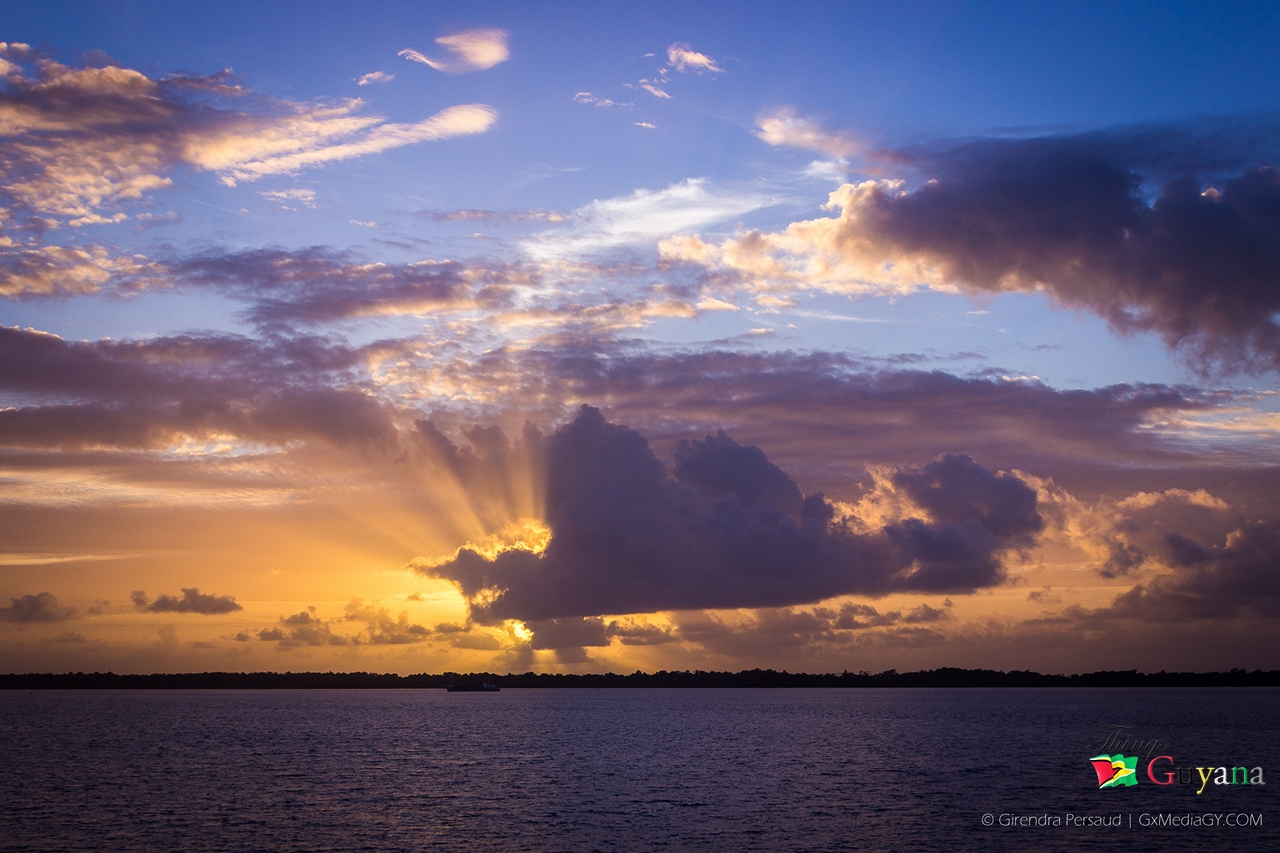The Essequibo River is the largest river in Guyana, and the largest river between the Orinoco and Amazon. Rising in the Acarai Mountains near the Brazil-Guyana border, the Essequibo flows to the north for 1,010 kilometres (630 miles) through forest and savanna into the Atlantic Ocean.
There are countless rapids and waterfalls (e. g., Kaieteur Falls on the Potaro river) along the route of the Essequibo, and its 20-kilometre (12 mi) wide estuary is dotted with numerous small islands. It enters the Atlantic 21 kilometres (13 mi) from Georgetown, the capital city of Guyana. The river features Murrays Fall, Pot Falls, and Kumaka Falls.
Its many tributaries include the Rupununi, Potaro, Mazaruni, Siparuni, Kiyuwini, Konawaruk and Cuyuni rivers. For over 30 kilometres (19 mi) from its mouth, the river’s channel is divided by the large flat and fertile islands of Leguan, about 28 square kilometres (11 sq mi), Wakenaam, about 44 square kilometres (17 sq mi), and Hog Island, about 60 square kilometres (23 sq mi). Fort Island is off the eastern side of Hog Island. Fort Island was the seat of government of the country during the Dutch colonial era.
The river has a very rich fauna. More than 300 fish species are known from the Essequibo basin, including almost 60 endemics.
The first European discovery was by the ships of Juan de Esquivel, deputy of Don Diego Columbus, son of Christopher Columbus. The Essequibo River is named after Esquivel. In 1499 Alonso de Ojeda explored the mouths of the Orinoco and allegedly was the first European to explore the Essequibo. Capuchin missionaries established missions in the territory before the Dutch settled along Esquivel’s River. In 1596 Lawrence Kemys, serving as second-in-command of Walter Raleigh’s British expedition to Guiana, led a force inland along the banks of the Essequibo River, reaching what he wrongly believed to be Lake Parime. The next year Kemys, in command of the Darling, continued the exploration of the Guiana coast and the Essequibo river.
The first European settlement in Guyana was built by the Dutch along the lower part of the Essequibo in 1615. The colonists remained on friendly terms with the Native American peoples of the area, establishing riverside sugar and cacao plantations.[citation needed] In a document detailing instructions for the Dutch Postholder in Cuyuni, it was mentioned that Indians (Venezuelan Amerindians) trading in Chinese slaves to sell to people who lived along the Essequibo river were to be allowed to conduct their business.
The Independence war of Venezuela beginning in the 19th century ended the missionary settlements. At this time, Britain needed to have a colony, besides Trinidad, to serve the large trade sailboats on their large travel trading route around South America. Venezuela claims that the Essequibo is the true border between it and Guyana, claiming all territory west of it. The boundary was set between Venezuela and Guyana’s then colonial power, Great Britain in 1899 through an arbitration proceeding. A letter written by Venezuela’s legal counsel, named partner Severo Mallet-Prevost of New York law firm Curtis, Mallet-Prevost, Colt & Mosle alleged that the Russian and British judges on the tribunal had acted improperly and granted the lion’s share of the dispute territory to Britain due to a political deal between Russia and the United Kingdom. As a result, Venezuela has revived its claim to the disputed territory.
Essequibo is also the name of a former Dutch colony founded in 1616 and located in the region of the Essequibo River that later became part of British Guiana.
Recent Expedition
In 2018, with the support of the First Lady, Sandra Granger, a group consisting of five Wai-wai, two English, one Iranian, and one South African located the furthest source of the Essequibo River. They built upon information and experience from the above 2013 Guyanese German expedition alongside topographical maps, local Wai Wai knowledge, GPS, and machetes to follow the Sipu River to its source. The multinational team [[Running the Essequibo]] followed the main channel and investigated tributaries, until they reached reached the watershed. There, 20 metres away from the Brazilian border, they logged what is now acknowledged to be the furthest source of the Essequibo River.
GPS co-ordinates N1’24.5243
W59’16.5107
The team then began their world-first descent of the Essequibo River. The team of nine paddled back to Kanashan, aka Gunns Strip, where the Wai Wai members returned home and Romel Shoni and Anthony Shushu joined the expedition. This team, accompanied later further downriver by Fay James (Macushi people), then paddled remaining distance to the mouth of the Essequibo where it meets the Atlantic Ocean.
This expedition lasted a total of 10 weeks.
Team members: Laura Bingham (expedition leader), Ness Knight, Pip Stewart, Peiman Zekavat (film director), Jon Williams (cameraman), Nereus Chekema, Nigel Isaacs, Jackson (Elijah) Marawanaru , Aron Marawanaru, James Suse, Fay James, Romel Shoni, and Anthony Shushu.
Article source: Wikipedia, viewed July 2016, https://en.wikipedia.org/wiki/Essequibo_River | Revised May 2019.
Picture: Sunrise on the Essequibo River.
Discover more from Things Guyana
Subscribe to get the latest posts sent to your email.







